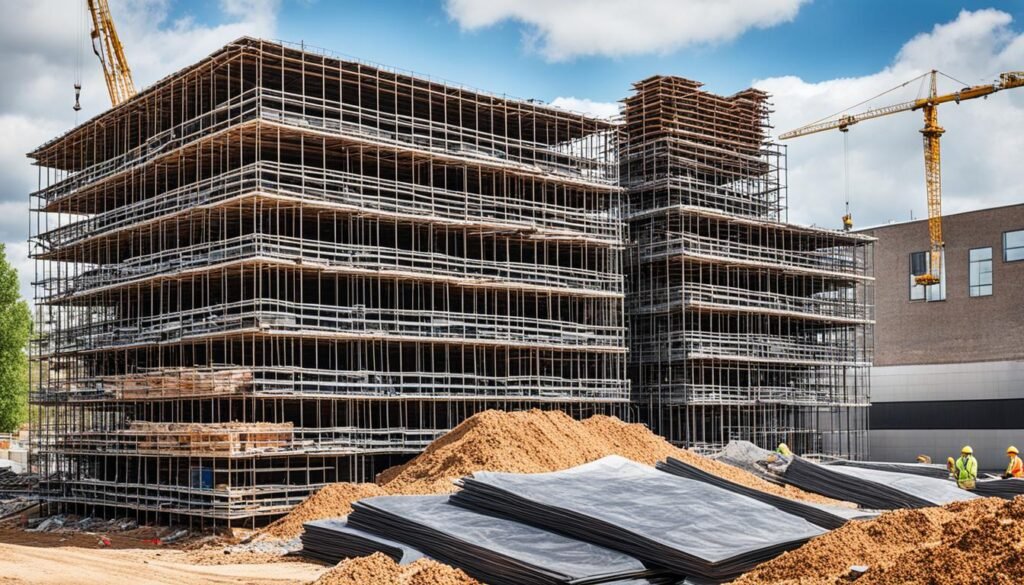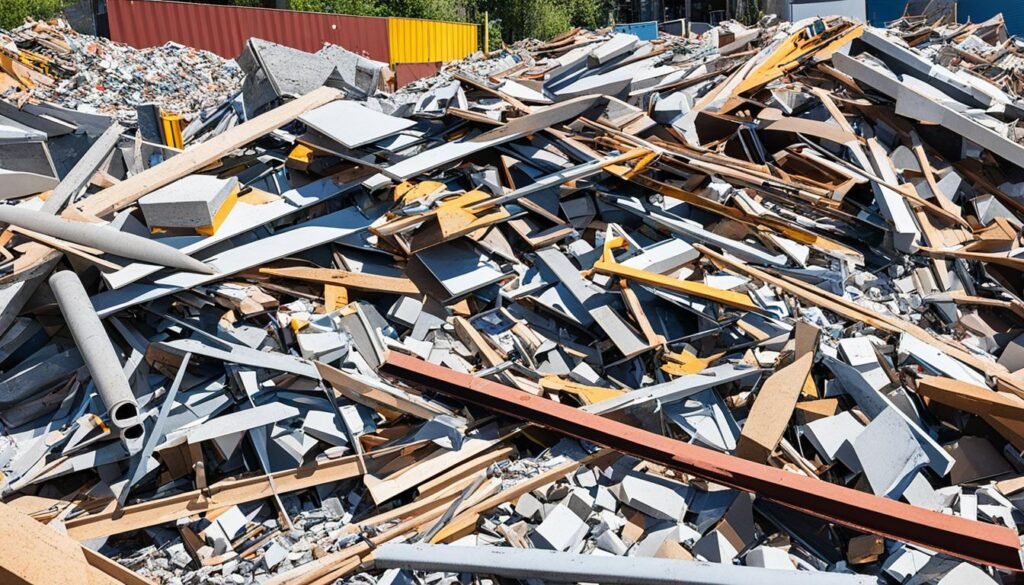Did you know that the construction industry generates a huge amount of waste? In the United States, it’s estimated that construction and demolition waste makes up more than 164 million tons every year.
Managing this waste well is key to lessening the environmental impact of building projects. It also helps promote sustainability. By recycling waste and choosing sustainable building methods, builders can cut down on waste. This improves their projects’ effect on the planet.
Key Takeaways:
- Construction and demolition waste generates over 164 million tons in the United States annually.
- Efficient construction waste management is vital for reducing environmental impact.
- Implementing waste recycling and sustainable construction practices can effectively reduce waste.
To make a difference for a greener future, the construction sector needs to focus on effective waste management. We’re going to look at several strategies to manage construction waste well. These include minimizing waste by optimizing designs, reusing materials, and choosing recyclable options.
Reducing Waste Through Design Optimization
Reducing construction waste is key and can be achieved through design optimization. By focusing on materials and wasting less, builders can create greener projects. This approach is both sustainable and eco-friendly.
Designing for Material Optimization:
Efficient material use is crucial in building design. Architects and engineers must select materials wisely to lessen waste and use materials better. This method looks at the needed quantity, type, and toughness of materials. It also uses new building ways to cut down on waste. This can greatly lessen the waste produced during building.
Material Selection:
Choosing the right materials is vital for reducing waste. Materials that are better for the environment and can be recycled should be selected. This reduces the need for new materials and supports recycling efforts. Choosing local materials also cuts down on transport waste and emissions.
Waste Reduction Strategies:
Waste can be greatly reduced by smart strategies early in the design stage. Using modular construction, prefabrication, and making parts off-site can help reduce waste. These tactics allow for precise material use and fewer mistakes. This leads to better resource use.
With thoughtful design and strategies, we can greatly lower construction waste. This promotes sustainable practices and lessens the environmental impact of building projects.

| Benefits of Design Optimization for Waste Reduction | Examples |
|---|---|
| 1. Minimizes material waste | An architect designs a building with standardized dimensions that align with the dimensions of commonly available construction materials, reducing offcuts and unused materials. |
| 2. Promotes efficient use of resources | A construction project utilizes building information modeling (BIM) software to optimize material quantities and minimize excess material procurement. |
| 3. Reduces project costs | An engineering firm designs a structure with a modular approach, allowing for the reuse of standardized components across multiple projects, minimizing waste and costs. |
| 4. Increases project efficiency | A contractor collaborates closely with architects and engineers during the design phase to ensure accurate material estimation and reduce the potential for rework. |
Reusing Materials and Selecting Recyclable Materials
Efficient construction waste management involves reusing existing materials. It’s also about picking materials that can be recycled. By doing this, builders greatly cut down waste. They also boost sustainability in their construction endeavors.
Reuse Existing Materials
One top way to lessen construction waste is through material reuse. Instead of tossing materials that are still usable, builders can save and use them again. This action saves resources and lessens waste. Here are ways to make the most of reuse:
- Incorporate reclaimed components: Use materials from torn-down buildings or saved construction parts in new projects. This approach lessens the need for new materials. Plus, it gives the project a unique flair.
- Optimize demolition processes: When taking down structures, do it in a way that saves reusable materials. Clean and fix up saved wood, bricks, and other parts. Then, use them in future construction work.
- Establish a material reuse program: Set up a system to keep track of reusable materials at the worksite. By organizing and listing salvaged materials, builders can easily find and use them later.
Select Recyclable Materials with High Recycled Content
Another smart move is choosing materials that are recyclable and have lots of recycled content. This helps the circular economy and saves resources. Keep these points in mind when picking materials:
- Evaluate recycled content: Look for materials with a lot of recycled content. For instance, there’s recycled steel, concrete aggregates, and plastic products. Using these materials cuts the demand for new resources and keeps waste out of landfills.
- Prioritize recyclability: Pick materials that can be easily recycled when they’re no longer needed. Example: Go for plastics with a clear recycling code. This makes sure materials don’t end up as waste but become something new instead.
- Consider product life cycle: Look at the whole life of materials, from where they come from to where they end up. Choose eco-friendly options that have a minimal environmental impact and promote sustainable practices.
These strategies don’t just reduce waste in construction. They also help move towards a sustainable construction industry. By reusing and selecting recyclable materials, builders make a difference. They conserve resources, reduce waste, and encourage sustainable methods.
Comparison of Reused and Recyclable Materials
| Material | Reuse Existing Materials | Select Recyclable Materials |
|---|---|---|
| Wood | Reworking salvaged timber for new construction projects | Choosing FSC-certified wood or composite lumber made from recycled wood fibers |
| Concrete | Breaking down concrete structures and using the crushed concrete as aggregate in new projects | Opting for concrete with high percentages of recycled content or incorporating supplementary cementitious materials made from industrial byproducts |
| Steel | Reusing steel beams and columns salvaged from deconstructed buildings | Using steel products manufactured with high recycled content, such as rebar made from recycled scrap metal |
| Plastics | Reusing plastic pipes and fixtures from demolished structures | Choosing recyclable plastics labeled with the resin identification code for proper recycling |

Conclusion
Managing construction waste well is crucial for lessening the harmful effects on our planet and encouraging sustainability. Using smart design, reusing items, and picking recyclable options are great ways to cut down waste. Plus, it makes your project more eco-friendly. It’s really important to think about reducing waste right from the project’s start. And, get everyone involved in figuring out how to handle waste.
When everyone works together and thinks about the whole life of materials, the building world can adopt greener habits. This will help us all aim for a more eco-friendly future. *Conclusion*
By choosing smart waste management in construction, you’re not just lowering landfill waste. You’re also saving precious resources and lessening your projects’ harm to the environment. Embracing sustainable practices like designing to use less material, reusing what’s already there, and going for recyclable materials is key. This is how you reach those waste-reducing targets.
FAQ
How can construction waste be effectively reduced?
What is design optimization in construction waste management?
How can materials be reused in construction projects?
What are recyclable materials in construction?
Why is efficient construction waste management important?
Source Links
- https://www.zerowastedesign.org/02-building-design/fa-construction-demolition-waste-best-practice-strategies/
- https://www.seagulldisposal.com/2024/04/26/construction-site-waste-management-best-practices-for-builders/
- https://wastecontrolinc.com/2023/02/28/construction-waste-management-how-to-effectively-handle-construction-waste/
